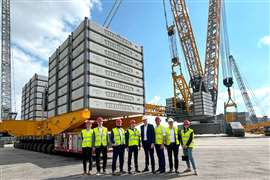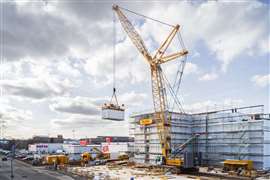Site condition do's and don'ts
24 April 2008

On a construction project, site conditions change every hour, if not by the minute. There are multiple parties doing multiple jobs, leaving plywood here, moving trusses there, setting ladders on the ground, etc., which begs the question, “Who is responsible for the overall conditions of the jobsite?”
If you are not careful, the answer could be you. Long gone are the days where work could be done with a handshake. Subcontractors, general contractors and owners have become increasingly aware of the direct correlation between their loss history and the cost of insurance, as well as the need for a good loss history to secure a reputation for safety to allow expansion.
The control and responsibility of site conditions can arise either by duty or contractually. Historically it has been the general contractors who have been deemed to have overall control of the job and jobsite, and courts have recognized this historic duty, presumably because the general contractor is present and aware of what is going on at every stage of the project, and as “general” they are first in command. General contractors, however, occasionally want to shirk this duty to maintain the site, and often are successful in transferring this duty to subcontractors. This is done through incorporation of the prime contract between owner/developer and general contractor and by the explicit contractual language in the subcontractor agreement that the general contractor makes the subcontractor, XYZ Crane, sign.
Responsibility through incorporation
Incorporation in terms of a subcontract agreement means to make other documents part of the contract, which can include both the prime contract and governmental regulations. For proper incorporation, the subcontractor agreement needs to incorporate these documents by reference. This creates multiple problems for XYZ Crane, which is bound by the additional obligations of the prime contract and governmental regulations that may include responsibility for site conditions.
To make matters even worse for XYZ Crane, often the contractors to whom they are renting a crane or hoist will not make available to them the prime contract for viewing to determine what these additional obligations are. Courts have taken various views on this and while a contractor may be able to use a conscionability defense (i.e. a defense available to small-time subcontractors as a result of unfair bargaining power in relation to a general contractor), other courts have taken the view that when the subcontractor agreement incorporates these documents properly, it is the responsibility of XYZ Crane to understand these obligations and not contract blindly. It is highly advisable, therefore, for XYZ Crane to make sure it gets access to the prime contract so that it is advised of these additional obligations and responsibilities.
Responsibility by agreement
Another way XYZ Crane can become responsible for overall site conditions is through a subcontract agreement. This can be disguised as a safety provision that states something along the lines of “subcontractor shall conduct inspections to determine that safe working conditions and equipment exist and accepts full responsibility for providing a safe place to work.” First of all, if conditions change by the minute, it is difficult to inspect them often, especially when XYZ's operator is doing the job he is hired to do, which is operating the crane. Further, what about other subcontractors who are on the jobsite and making it unsafe, and it is XYZ Crane's obligation to clean up their messes?
Other subcontractor agreements have provisions that state “subcontractor shall remove from the premises, as often as directed by the contractor, all rubbish, debris and surplus material which may accumulate from the prosecution of the work and should the subcontractor fail to do so upon such notice, then the contractor may, at his option, cause the same to be removed and charge the expense of the removal to the subcontractor.”
The aforementioned clause was one of the problems that precluded the subcontractor in Benson Paint Co. versus Williams Construction Co. from a granting of their motion for summary judgment. In this case a plaintiff brought suit against a general contractor after stepping off a ladder, slipping on a piece of conduit and falling on a glass bottle. The general contractor in turn sued the subcontractor, arguing that the general contractor had turned over the control of the premises to the subcontractor, and it was the subcontractor's obligation to maintain the premises in a safe manner. While the court recognized that the general contractor had the overall responsibility for the removal of the debris, regardless of this responsibility, the subcontractor was responsible for this removal when directed by the general contractor under the express terms of the contract. If the general had directed the sub to remove the debris, the sub would be required to indemnify the general, because under the indemnity clause, the sub was required to indemnify the general for his negligence. Failure to remove the glass bottle, regardless of whether the glass bottle came from the subcontractor, if told by the general to remove the debris, would be negligence on the part of the subcontractor.
Protecting your company
Site conditions not only include visible materials, structures or debris, but also include ground conditions and subsurface voids that may affect the performance of your work and ultimately may cause damage to your equipment. Above we examine how site condition responsibility is flown down through contract provisions; however, ground conditions can be flown up, such that you make it the responsibility of the general (or whomever you are hired by) by contract to make sure the ground on which XYZ Crane works is stable. This is important because the nature of crane work is to arrive on the jobsite and set up where the lessee of the crane tells you to do so. If the lessee is the general contractor, they have been working the job longer and are presumably familiar with subsurface voids and ground conditions from both the project specifications and from onsite observation. A ground condition provision such as that described below can protect you against this type of exposure, and may assist you in subrogating damage to your crane in the event your crane overturns from ground instability:
“The lessee hereby agrees that it will assume all responsibility for the ground or soil conditions in the area where the crane is to be stored, parked or operated. The lessee shall perform or have performed all necessary inspections or testing to determine the nature of the ground or soil and its ability to support the crane while in operation or otherwise. If the ground or soil condition is such that it cannot support the crane, the lessee shall take all necessary measures to insure that these conditions are remedied prior to the crane being placed on that ground or soil. These measures include, but are not limited to, the provision of proper shoring or cribbing or other measures.”
Claims investigation
Such a provision was used in a daily work ticket when a loss occurred to XYZ Crane, claim number SRSA-1234. XYZ Crane was hired to work on a condominium project by ABC Construction. The day prior to XYZ's work, a water main had broken and ABC (as well as the city) had knowledge of this. The next day, XYZ Crane set up their crane on matting (plywood boards) over the ground, unbeknown to them that a water main had broken. After set up and upon the beginning of operation, the crane slowly tipped forward as the ground gave way, causing damage to the crane as well as an adjacent condominium building.
A geotechnical engineer and attorney were hired immediately to go to the scene, and it was determined by the geotechnical engineer that the cause of the loss was directly a result of the ground failure and the water main break, which had caused a lack of buoyancy in the ground. The loss has been tendered to ABC Construction, based on the provision in the daily work ticket.
Not only does the above loss indicate the importance of prompt notification, it illustrates the importance of a ground conditions provision. The amount of the crane damage was in excess of $200,000 and the amount of the liability damage was in excess of $50,000. These were able to be deflected by XYZ Crane. In conjunction with review of a subcontractor agreement you are made to sign to identify what site conditions the general is attempting to make you responsible for, a ground conditions provision in your daily work ticket can help you avoid the risk of loss. act
STAY CONNECTED


Receive the information you need when you need it through our world-leading magazines, newsletters and daily briefings.
CONNECT WITH THE TEAM











